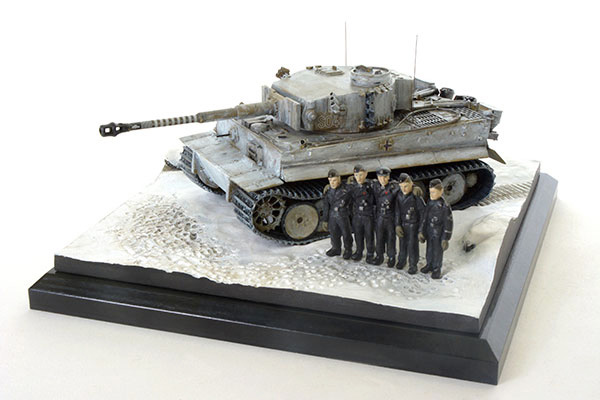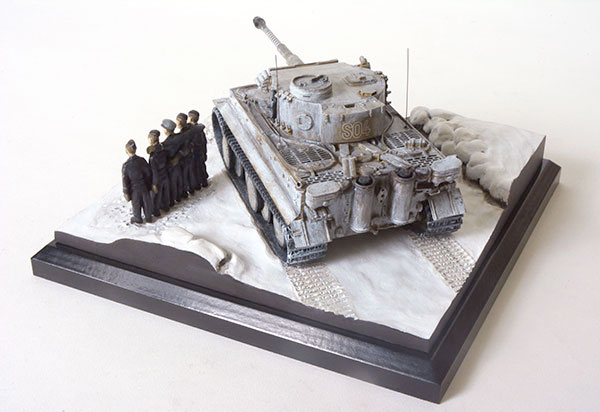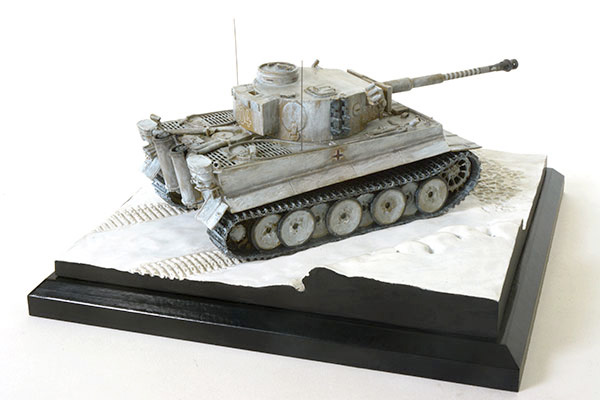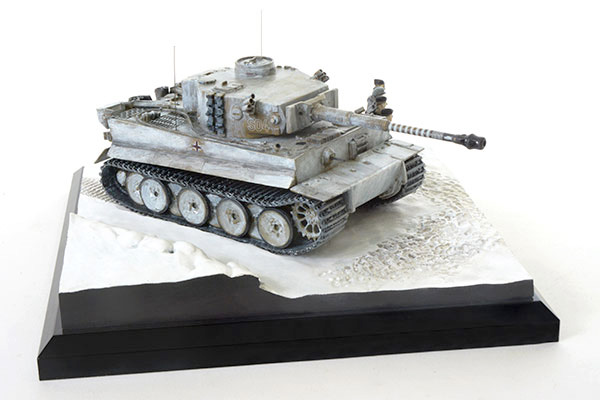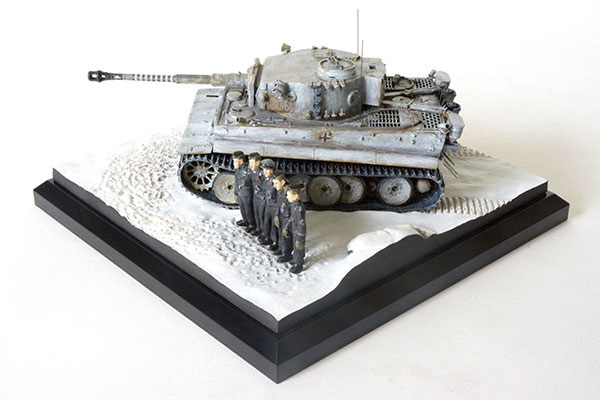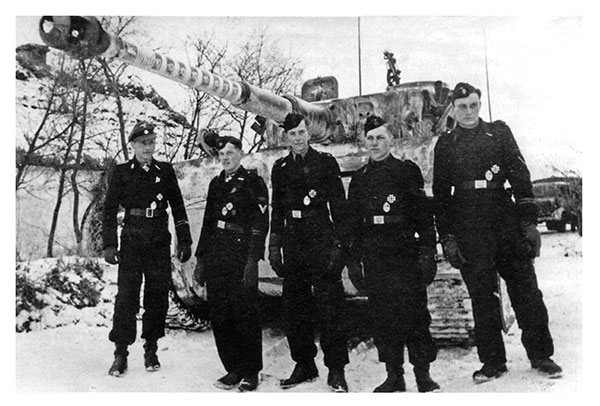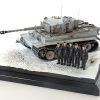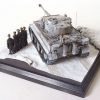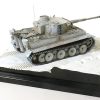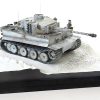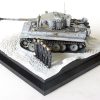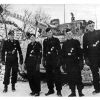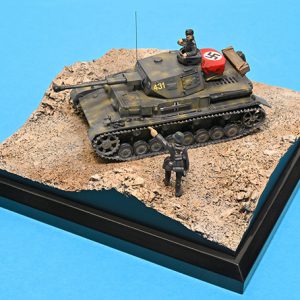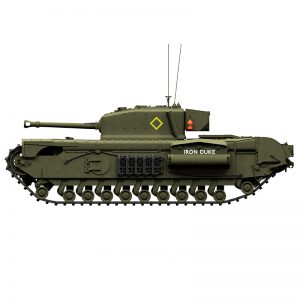Panzerkampfwagen VI Tiger I Ausfühurung H1, ‘S04’,
SS-Hauptsturmführer Michael Wittmann
1st SS Panzer Division “Leibstandarte SS Adolf Hitler”,
‘Operation Citadel’, Kursk, 1943
Model based on photos from January 1944.
Few weapons of war have generated such fear in the enemy as the Tiger tank. It has earned legendary status as a formidable battle tank. The combination of heavy armour and the well proven 88mm KwK 36 gun made it a near invincible battlefield weapon in its day.
From early tank conflicts in World War II the German Army had discovered that tanks such as the French Somua S35, Char B1 and the British Matilda II showed up the inadequacies of the German armour. In battle they were not only out gunned by allied tanks but had insufficient armour protection. Development of a heavy tank had started in 1937 when the German Army weapons agency (Waffenamt) had requested Henschel to develop a Durchbruchwagen (‘breakthrough vehicle’) in the 30-33 tonne range. A prototype was built but never fully developed. Further vehicles were built using the Schachtellaufwerk concept of overlapping and interleaved main roadwheels. This was a design already in use on German half-tracks such as the SdKfz 7. In May 1941 Henschel and Ferdinand Porsche were asked to submit designs for a 45 tonne heavy tank to be ready by June 1942. Both designers worked on developing earlier concepts with Henschel building two prototypes; one with a 75mm gun the other with an 88mm.
On June 22nd 1941 Germany launched ‘Operation Barbarossa’ the invasion of Russia. They were not prepared for the resistance they encountered from the Russian tanks. The revolutionary T-34 with its sloping armour was immune to almost all German tanks and the KV-1 tank was impregnable to all weapons except the 88mm Flak gun. A new design was needed and an immediate weight increase to 45 tonnes and increase in calibre to 88mm was passed on to the two tank designers. The due date for the new prototypes was set for 20th April 1942 (Adolf Hitler’s birthday). The new prototypes were submitted, each making use of the Krupp designed turret. The Porsche design was rejected as its troubled petrol-electric hybrid concept relied on supplies of copper, a material available in limited supply at the time to the Germans. Production of the new Henschel designed Panzerkampfwagen VI Ausf H began in August 1942. Expecting to win the contract Porsche had already built 100 chassis based on his design. These would later be converted to the Panzerjäger Tiger (P) known as the ‘Ferdinand’ after Ferdinand Porsche who had given his original design the name ‘Tiger’.
The new Tiger I was a significant step up from earlier German tanks weighing twice that of the Panzer IV medium tank at over 50 tonnes. The Tiger was fitted with an 88mm Kwk 36 gun, this is not to be confused with the 88mm Flak 36 which is a totally different weapon. With frontal armour of 100 mm and side armour of 80 mm the Tiger I was almost impervious to frontal fire from 75mm tanks such as the Sherman and Cromwell. It was not until up-gunned Shermans and another step in allied tank development had taken place would the Tiger meet its match.
Early Tigers were pressed into service on the 23rd of September 1942 near Leningrad, but in the swampy terrain they were largely confined to the roads and plagued with reliability issues hampering their combat ability. It was not until December 1942 when they would see action in North Africa.
In the summer of 1943 the conflict on the Eastern front was reaching a climax and it would be at Kursk some 280 miles south west of Moscow that Operation Citadel would take place. Operation Citadel became the largest tank battle in history ultimately seeing the Soviets regaining territory along a 1200 mile wide front after the battle. The Germans would lose 760 tanks compared to the 6064 lost by the Russians. The German forces were better equipped but they lacked the numbers to make the battle decisive.
Operation Citadel would create many heroes and aces both on the ground and in the air, one such ace was Michael Wittmann. Born in Bavaria in 1914 Wittmann joined the German Army in 1934 and the SS in 1937 when he was assigned to the regiment Leibstandarte SS Adolf Hitler (LSSAH). A year later he participated in the annexation of Austria and the occupation of the Sudetenland, he then joined the Nazi Party. Wittmann’s unit was transferred to the Eastern Front in the spring of 1941 for Operation Barbarossa where he commanded a Stug II assault gun and later a Panzer III. In 1943 he commanded a Tiger I and by the Battle of Kursk he had become Platoon Leader. On January 1944 Wittmann was awarded the Knight’s cross of the Iron Cross. This presentation was photographed extensively with Wittmanns crew in front of his Tiger ‘S04’ and is the subject of the diorama. Two weeks later Wittmann was awarded the Knight’s Cross of the Iron Cross with Oak Leaves for the destruction of 117 tanks. This was personally presented by Adolf Hitler at the Wolf’s Lair, Hitler’s headquarters in Rastenburg, on February 1944.
Famously Wittmann would go on to carry out one of the most audacious actions of the Normandy campaign at Villers-Bocage. This would gain him further glory and honours before finally meeting his end on the 8th of August 1944, his Tiger I destroyed by a Sherman Firefly. Wittmann was the fourth highest scoring ace of all time with 135 kills.
By the end of the war the Tiger I had been replaced by heavier, bigger gunned panzers such as the Tiger II but its place in history was secured. Today few Tigers survive and only one is in running order based at the Bovington Tank Museum.


